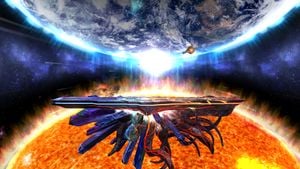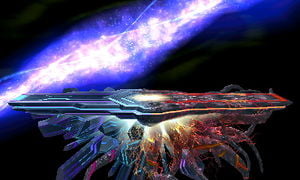| Final Destination | |
|---|---|
  
| |
| Universe | Super Smash Bros. |
| Appears in | SSB4 |
| Availability | Starter |
| Crate type | Futuristic (SSB3DS) Normal (SSBU) |
| Maximum players | 4 |
| Tracks available | 3DS Final Destination Menu (Melee): Ver. 2 (Alternate) Wii U Final Destination Final Destination Ver. 2 Master Hand Menu (Melee): Ver. 2 Credits (Super Smash Bros.) Metal Battle (Melee) Final Destination (Melee) Giga Bowser (Melee) Final Destination (Brawl) Boss Battle Song 2 (Brawl) Master Core Master Fortress: First Wave Master Fortress: Second Wave Bolded tracks must be unlocked |
Final Destination (終点, Endpoint) is a stage in both versions of Super Smash Bros. 4. Like in previous games, this is where Master Hand and Crazy Hand are fought, along with the new boss Master Core starting at 5.1 Intensity in Classic Mode.
Stage layout
Like all versions of Final Destination, the stage consists in a single floating platform with no hazards. The background shows large planets zooming by, followed by a bright white flash which marks the transition to a sky background. The background differs between the Wii U and 3DS versions.
Gallery
3DS Images
Kirby and Master Hand on the standard Final Destination.
Master Hand transforming into Master Core.
Battling Master Core on the standard Final Destination.
Another shot from the Master Core battle.
Pikachu, Samus, and Mii Brawler in the standard Final Destination.
Wii U Images
Trivia
- In the PAL French version of Super Smash Bros. for Nintendo 3DS, DF stands for "Destination Finale".
- This is the first iteration of Final Destination to use sound effects for the changing background animations.
- Masahiro Sakurai stated that the first two games in the series had strong fiery imagery to convey a burning, passionate motif. Brawl had sky imagery to convey a more free motif. Since SSB4 was designed to feel right in between Melee and Brawl, the blazing sun and sky blue earth in the background of this stage may be representing this dichotomy of gameplay styles.
